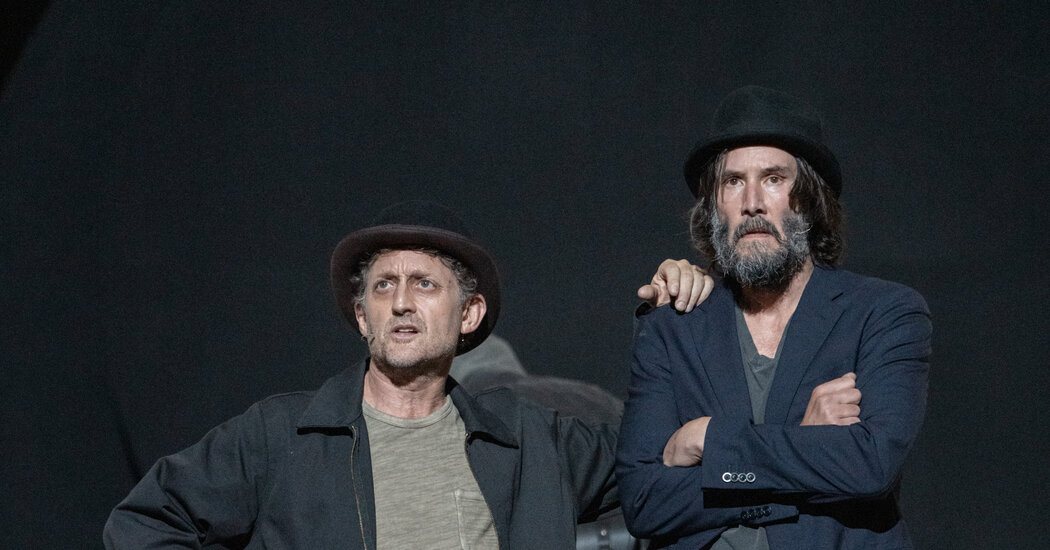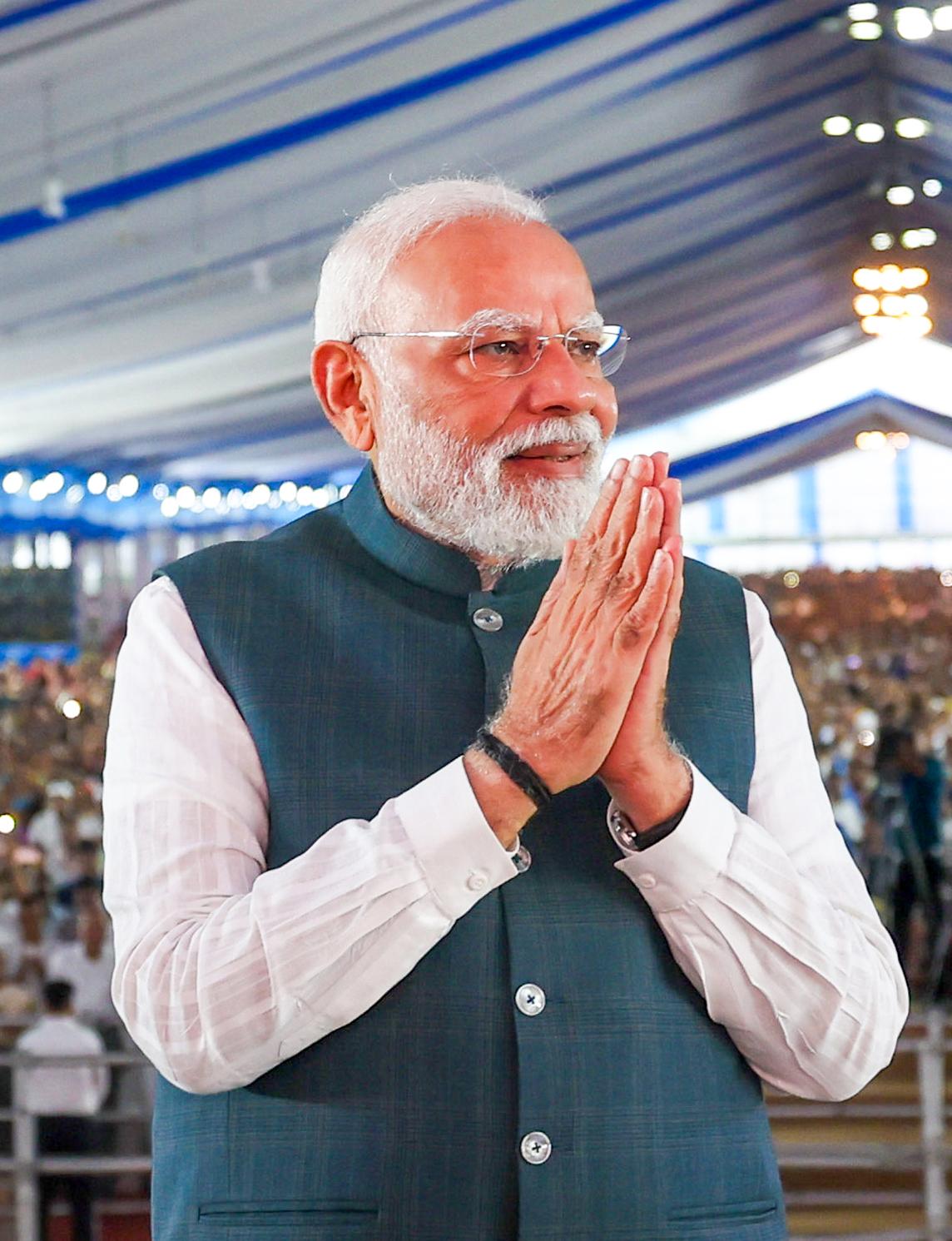
Does air guitar belong in a Samuel Beckett classic? The playwright’s infamously meticulous stage directions somehow fail to mention it anywhere in “Waiting for Godot,” an existential tragicomedy whose anguished heroes, Vladimir and Estragon, are not known for their rock ’n’ roll shredding.
But the California goofballs Bill and Ted are. The raison d’être of the current Broadway revival of “Waiting for Godot” is the public reunion of the actors who portrayed them in a series of popcorn movies, starting with the 1989 time-travel hit “Bill & Ted’s Excellent Adventure.”
Alex Winter, who played Bill, stars as Vladimir, opposite Keanu Reeves, who played Ted, as Estragon — the weathered pair of them inhabiting a void that they cannot escape. Parting and reconnecting, again and again, they have been together seemingly forever: a bowler-hatted double act.
“Back to back like in the good old days!” Estragon exults somewhere in Act II, standing spine to spine with Vladimir and speaking the line just as Beckett wrote it. Whereupon Reeves and Winter indulge in a burst of air guitar, Bill and Ted-style. The riff is a surefire crowd-pleaser, and maybe equally sure to rankle the purists. Already, I have heard some of them grumble rather fiercely.
Me, I laughed — because it tickled me, because it was a welcome moment of liveliness and also because Vladimir, a.k.a. Didi, and Estragon, a.k.a. Gogo, are clowns. Uncontainable rebellions of playfulness suit them. If the show briefly acknowledges what it means for much of the audience to see Reeves and Winter together again, echoing their big-screen history as they portray a different pair of friends, what of it? Clowns are meant to color outside the lines.
Jamie Lloyd’s pristinely chic-looking production, which opened on Sunday night at the Hudson Theater, breaks some other rules, too, right from the start. There is no customary tree as part of the scenery, for one thing, and no country road. This Didi and Gogo while away their endless days inside a kind of tapering tunnel that has an enormous gaping mouth at the downstage end, where they perch on its lip, nice and close to the orchestra seats.
Visually striking spareness is a hallmark of Lloyd’s work with Soutra Gilmour, the set designer who is his longtime collaborator, and who designed the show’s immaculate costumes, too. Exquisite minimalism is what New York audiences have seen them make together in “Sunset Boulevard,” “A Doll’s House,” “Cyrano de Bergerac” and “Betrayal” — intelligent, star-powered re-envisionings all.
What’s curious in “Waiting for Godot” is that the textual distillation we have come to expect from Lloyd is largely missing. So is his interpretive stamp. For the most part here, he doesn’t seem to have anything to say. That’s disappointing on its own, because the play needs strong directorial focus to land with any force, but particularly so at a time when surely a good chunk of the populace could identify with Didi and Gogo’s sense of exhaustion, futility and despair in the face of a relentlessly brutal world.
“Nothing to be done,” each of them says, repeatedly.
Lloyd’s skill as something of a star whisperer isn’t much in evidence, either. For Reeves, who initiated this production, and Winter, the stage is not a usual habitat. These feel like performances that are still taking shape, Winter’s in particular, with Didi grim-visaged almost throughout. Reeves has a tentativeness, too, but his Gogo is endearing in a familiar way, with a puppyish vulnerability.
It isn’t that Reeves and Winter are underprepared; they have done their research, and diligently. But they have not yet reached the point at which they can let that scaffolding fall away as they slip at last into the skin of their characters. For now, they appear still to be standing at a distance from them, intimidated.
Didi and Gogo spend their restive, blurred-together days in hope of a promised rendezvous with the elusive Godot, whose name in this production is pronounced GOD-oh: a solid hint to meaning. Didi and Gogo live in doubting, suspended animation, awaiting the certainty of his instructions.
“Well?” Didi asks Gogo. “What do we do?”
“Don’t let’s do anything,” Gogo suggests. “It’s safer.”
This Didi and Gogo speak the words, but without the weight and meaning of the thoughts they have thought countless times before, and without any volleying rhythm to their conversation. It is a subdued recitation rather than an illumination of the play, the meaning lost as the words hit the air.
Despite Lloyd’s practice of doing away with props — which results in the genuine fun of watching Reeves eat an invisible carrot and talk with his mouth full — the production feels cramped inside its wooden tube. It is also hurried and surface-skimming rather than depth-plumbing, and less funny than it needs to be because it is less human than it needs to be.
When the passers-by Pozzo and Lucky steal the show, you know something has gone seriously awry — and Pozzo and Lucky, deftly melding the comical with the alarming, saunter right off with this one.
To be fair, Lloyd enlisted absolute stage pros for those roles: Brandon J. Dirden (“Take Me Out”) as the cruel and mercurial Pozzo, and Michael Patrick Thornton (Lloyd’s “A Doll’s House”) as Lucky, his slave. Under Jon Clark’s eerie lighting, their presence is instantly electrifying — Pozzo a honey-tongued Southern gentleman when he feels like it, a merciless bully otherwise. Vain and finicky, he is the kind of tyrant who you know will not fail to stop for a manicure on the road to hell, which in the Christian framework of Beckett’s play is surely his final destination.
Lucky, who has a black muzzle covering most of his face, is a surprising charmer, aware of the audience and enlisting our cooperation in his darling dance number, which he performs in his wheelchair. When, muzzle off, he delivers his gargantuan monologue — a Joycean stream of consciousness often performed as mind vomit — Thornton speaks with great clarity and calm, as if it makes utter sense, as if Lucky is exhaling at having an unfettered interlude to think aloud.
Didi and Gogo do succeed better in Act II, when the production’s inertness gives way to physical comedy. Some vaudeville business with bowler hats, which Beckett choreographed, gets delighted laughs.
The thing to keep in mind is that even on Broadway, not every show enters the world fully baked. Theater evolves performance by performance; it’s not a static product.
So while it isn’t a sure thing that Reeves and Winter can rise to the level of Dirden and Thornton, bringing a necessary balance to the production, there certainly is a chance. Like Didi and Gogo, trying afresh each new day, they have time.
Waiting for Godot
Through Jan. 4 at the Hudson Theater, Manhattan; godotbroadway.com. Running time: 2 hours 5 minutes.



